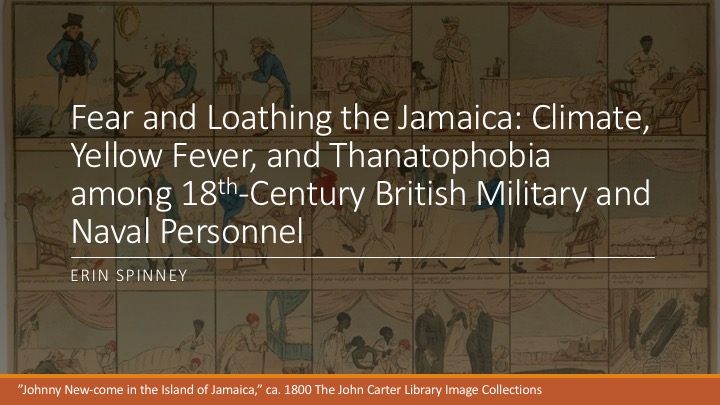Further Resources:
Images used in this paper:
Arrowsmith, John. “West Indies.” (London: John Arrowsmith, 1832). Link
“Bag for cinchona bark, Peru, 1777-1785” by Science Museum London. Credit: Science Museum, London
‘Cinchona plant (Cinchona officinalis): flowering and fruiting branch. Coloured etching by J. Pass, c. 1801, after J. Ihle’ by Johann-Eberhard Ihle. Credit: Wellcome Collection.
Jefferys, Thomas. “Engraved Title Page: West-India atlas: or, a compendious description of the West-Indies.” London: Sayer and Bennett, 1788. Link.
“Johnny New-come in the Island of Jamaica.” (London: Willm. Holland, 1800). Link
‘Naval officers and men on a ship, dressed in the uniform of nine labelled ranks of the Royal Navy. Wood engraving.’. Credit: Wellcome Collection.
Pariset, Etienne and Andre Mazet. Observations sur la fièvre jaune, faites à Cadix, en 1819. Credit: Wellcome Collection
Archival Sources:
National Maritime Museum
ADM/E/46: ADM/E/46 “Sick and Hurt Board, In-Letters and Orders 1797-1798.”
Wellcome Library
RAMC 210 “Volume of copy letters and reports.” 1811-1823.
Printed Primary Sources:
Bell, John. An Inquiry into the Causes Which Produce, and the Means of Preventing Diseases Among British Officers, Soldiers, and Others in the West Indies. London, 1791.
Fergusson, William. Notes and Reflections on a Professional Life. London: Longman, Brown, Green, and Longman, 1846.
Henderson, Stewart. A Letter to the Officers of the Army Under Orders For, Or That May Hereafter Be Sent to the West Indies, on the Means of Preserving Health, and Preventing That Fatal Disease the Yellow Fever. London: John Stockdale, 1795.
Laughton, John and James Sullivan eds. Journal of Rear-Admiral Bartholomew James. London: Navy Records Society, 1896.
Lempriere, William. Practical observations on the diseases of the army in Jamaica, as they occurred between the years 1792 and 1797, Volume 1 and 2. London: T. N. Longman and O. Rees, 1799.
McLean, Hector. An enquiry into the nature, and causes of the great mortality among the troops at St. Domingo. London: T. Cadell and W. Davies, 1797.
Moseley, Benjamin. A Treatise on Tropical Diseases; On Military Operations; and on the Climate of the West-Indies. London: G. G. and J. Robinson, 1795.
Reide, Thomas Dickson. A view of the diseases of the army in Great Britain, America, the West Indies, and on board of King’s ships and transports. London: J. Johnson, 1793.
Secondary Sources:
Alsop, J. D. “Warfare and the Creation of British Imperial Medicine, 1600-1800.” In British Military and Naval Medicine, 1600-1830, edited by Geoffrey L. Hudson, 23-50. Amsterdam: Rodopi, 2007.
Arnold, David ed. Warm Climates and Western Medicine: The Emergence of Tropical Medicine, 1500-1900. Amsterdam: Rodopi, 1996.
Bailey, Mark S. “A brief history of British military experiences with infectious and tropical diseases.” Journal of the Royal Army Medical Corps 159 (2013): 150-157.
Buckley, R. Norman. The British Army in the West Indies: Society and the Military in the Revolutionary Age. Gainesville, FL: University of Florida Press, 1998.
Buckley, R. Norman. Slaves in Red Coats: The British West Indian Regiments, 1795-1815. New Haven: Yale University Press, 1979.
Burnard, Trevor. “’The Countrie Continues Sicklie’: White Mortality in Jamaica, 1655-1780.” Social History of Medicine 12(1) (1999): 45-72.
Charters, Erica. Disease, War, and the Imperial State: The Welfare of the British Armed Forces during the Seven Years’ War. Chicago and London: The University of Chicago Press, 2014.
Churchill, Wendy. “Efficient, Efficacious and Humane Responses to Non-European Bodies in British Military Medicine, 1780-1815.” The Journal of Imperial and Commonwealth History 40(2) (2012): 137-158.
Crewe, Duncan. Yellow Jack and the Worm: British Naval Administration in the West Indies, 1739-1748. Liverpool: Liverpool University Press, 1993.
Dobson, Mary. “Mortality Gradients and Disease Exchanges: Comparisons from Old England and Colonial America.” Social History of Medicine 2(3) (1989): 259-297.
Duffy, Michael. Soldiers, Sugar, and Seapower: The British Expeditions to the West Indies in the War against Revolutionary France. Oxford: Clarendon Press, 1987.
Dunn, Richard. Sugar and Slaves: The Rise of the Planter Class in the English West Indies, 1624-1713. Chapel Hill: University of North Carolina Press, 1972.
Elliz, David. “Revolution, War, Empire: Gendering the Transatlantic Slave Trade, 1776-1830.” In Gender, War and Politics: Transatlantic Perspectives, 1775-1830, edited by Karen
Hagemann and Gisela Mettele, 169-187. London: Palgrave Macmillan, 2010.
Harrison, Mark. “’The Tender Frame of Man’: Disease, Climate, and Racial Difference in India and the West Indies, 1760-1860.” Bulletin of the History of Medicine 70(1) (1996): 68-93.
Humphreys, Margaret. Yellow Fever and the South. Baltimore and London: Johns Hopkins University Press, 1999.
Kupperman, Karen Ordahl. “Fear of Hot Climates in the Anglo-American Colonial Experience.” William and Mary Quarterly 41(2) (1984): 213-240.
McNeill, J. R. Mosquito Empires: Ecology and War in the Greater Caribbean, 1620-1914. Oxford: Oxford University Press, 2010.
Nash, Linda. “Beyond Virgin soils: Disease as Environmental History.” In The Oxford Handbook of Environmental History, edited by Andrew C. Isenberg, 76-107. Oxford: Oxford University Press, 2014.
Newman, Simon. A New World of Labor: The Development of Plantation Slavery in the British Atlantic. Philadelphia: University of Pennsylvania Press, 2013.
Voelz, Peter. Slave and Soldier: The Military Impact of Blacks in the Colonial Americas. New York: Garland Publishing, 1993.
Warren, Christian. “Northern Chills, Southern Fevers: Race-Specific Mortality in American Cities 1730-1900.” The Journal of Southern History 63(1) (1997): 23-56.

Comments are closed